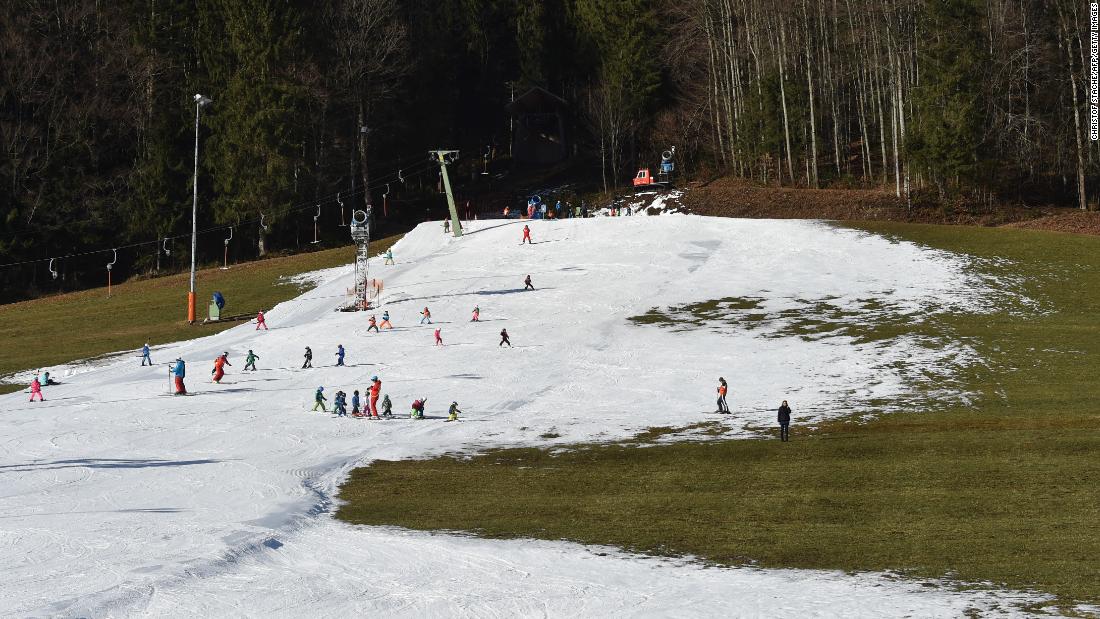Their problem? One of the weekend’s main events was a 15-kilometer race. According to International Ski Federation (ISF) guidelines, that event requires at least a 5-kilometer skiing loop.
When nature isn’t on your side, you need to get a little creative.
“We knew the event was going to go ahead, there was no doubt about that,” Jan Skricka, the competition’s secretary general, told CNN. “But we also knew we won’t be able to build a full 5-kilometer circuit, so it was a question of figuring out a way around it.”
It made for a tough couple of weeks for Skricka and his team, but in the end their event was a success. Thousands of spectators came to cheer on the world’s skiing elite.
That competition’s initial snow troubles might soon be forgotten, but the issue won’t go away.
The next leg of the cross-country world cup was held in Oberstdorf in Germany. In order to host a recent ski jumping competition, the groundskeepers there had to bring in truckloads of old snow.
Ski seasons are getting shorter
The International Olympic Committee (IOC) is well aware of the problem. In a report examining the impact of climate change on future winter games, the committee warned that as temperatures increase, the snowline will rise, meaning fewer places around the world will be suitable for skiing and other winter sports.
The IOC report forecast that an increase of 1 degree Celsius (1.8 degrees Fahrenheit) would push the snowline up by 150 meters. “The ski season may start up to a month later and finish up to three months earlier,” the committee said.

Organizers had to bring in old snow for the ski jump competition in Oberstdorf last month.
CHRISTOF STACHE/AFP/Getty Images
When scientists from the Royal Netherlands Meteorological Institute looked at snow depth data from 1,131 weather stations across Europe, they found that, on average, mean snow depth had decreased by more than 12% a decade over the past 66 years.
The IOC said warming temperatures were particularly bad news for ski resorts located below altitudes of 1,000 meters.
Nove Mesto, which lies just 600 meters above sea level, is a prime example of this.
A couple of years ago, the city realized that local snow conditions there were too unpredictable for a place that wanted to host major winter sports competitions, so it built a giant snow storage facility.
Skricka credited that decision with saving this year’s event.
But that solution isn’t without its problems. Northern China is already suffering from severe water stress and the area is becoming increasingly dry.
In an early assessment of the venue, the IOC warned that Beijing appears to have “overestimated the ability to recapture water used for snow making,” and said it would likely need to divert water from other sources. But it went ahead and awarded the games to China anyway.
It will likely get worse
A vast majority of scientists agree that global warming is set to continue in future. The question is by how much.
That goal is ambitious and requires most countries around the world to drastically reduce their carbon emissions in the coming years. The United States, the world’s second biggest emitter, has withdrawn from the deal under President Donald Trump.

Artificial snow has saved the day for skiers in Ruhpolding, Germany.
CHRISTOF STACHE/AFP/Getty Images
Peer-reviewed research looking at changing weather conditions in 21 past Winter Olympics host cities found that even if emissions do drop, and overall warming is limited, only 13 of the cities will still be suitable for winter sports by 2050.
The scientists, led by Daniel Scott, professor of geography and environmental research at the University of Waterloo in Ontario, Canada, said if emissions don’t come down and the world continues its “business as usual” approach, only 10 of the 21 locations would be usable by 2050.
Nove Mesto is determined to go on for as long as it can, however. The cross-country world cup returned to the city this year after a four-year break and Skricka is hoping the event’s success will convince the ISF that the competition belongs there — even if the snow supply is tight.
